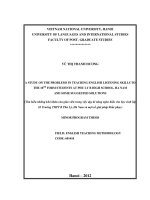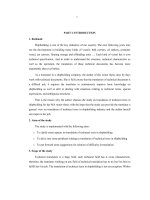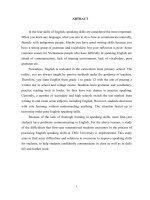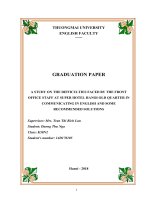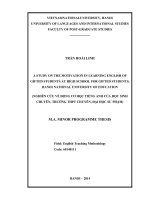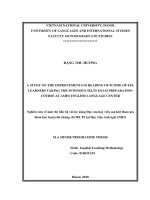A STUDY ON THE DIFFICULTIES IN PRESENTATION IN SPEAKING 2 LESSONS ENCOUNTERED BY STUDENTS OF K15ENGLISH PEDAGOGY IN FOREIGN LANGUAGES DEPARTMENT AT HUNG VUONG UNIVERSITY AND SOME SUGGESTED SOLUTIONS=Nghiên cứu về những khó khăn khi thuyết trình trong giờ
Bạn đang xem bản rút gọn của tài liệu. Xem và tải ngay bản đầy đủ của tài liệu tại đây (327.48 KB, 63 trang )
i
ACKNOWLEDMENT
With the responsibility and favour of the researcher and great help from
other people, this researcher has been developed for almost seven months.
Firstly, I wish to express my deep gratitude to my supervisor, Mrs.Dang
Luu Ngoc Hoa, MA who has been my trusted guide and accompanied me
through the completion of the thesis.
I am truly grateful to teachers in Foreign Languages Department at Hung
Vuong University as choosing my paper, creating favorable condition for me to
accomplish this thesis.
Great acknowledgement is also due to teachers and students in K15English Pedagogy for their help during my research process especially students
who enthusiastically gave their time to answer the research questions .
I would like to thank my friends, who always provide me with helpful
advice, ideas, and special encouragement.
Last but not least, I would like to thank my parents who always give me
special advice and encouragement to help me complete this study.
Finally, I hope that my research can be shared with all the people
mentioned above. I’ll have to thank all of them for the success today.
ii
ABSTRACT
Nowadays, English is considered as international language, which is
spoken by millions of people all over the world. The needs to use English to
communicate verbally are essential and increase more and more. Presentation
skill plays an important role in jobs, activities of public; especially in studying.
However, presentation in Speaking 2 Lessons for students in general and for
Students of K15- English Pedagogy in Foreign Languages Department at Hung
Vuong University in particular seems to have some obstacles.
This paper studies the real difficulties in presentation in Speaking 2
Lessons to find some suitable solutions for Students of K15- English Pedagogy
in Foreign Languages Department at Hung Vuong University. It is conducted
with the participation of 17 students at K15-English Pedagogical University,
Hung Vuong University. All needed data is collected through survey
questionnaire and class observation. It has been revealed that delivery is the
most difficult part in presentation in Speaking 2 Lesson for students. Especially
delivering the presentation clearly with good pronunciation was perceived by the
learners the most difficult of all. Then some solutions are suggested to enhance
presentation skills in Speaking 2 Lessons for Students of K15- English
Pedagogy.
It is hoped that this study will be useful for teachers and students at Hung
Vuong University in learning and teaching Presentation skill in Speaking
Lesson.
iii
LIST OF ABBREVIATIONS
HVU: Hung Vuong University
FLD: Foreign Languages Department
iv
LIST OF TABLES AND FIGURES
Table 1:
Table 2:
The importance of presentation in learning language and future job
The students’ frequency in making an oral presentation in Speaking
Lesson
Table 3:
The students’ difficulties in preparation of presentation
Table 4:
The students’ difficulties in organization of presentation
Table 5:
The students’ difficulties in delivery of presentation
Table 5.1: The students’ difficulties in getting and maintaining audience’s
attention
Table 5.2: The students’ difficulties in using body language
Table 5.3: The students’ difficulties in language use
Table 5.4: The students’ difficulties in time management, anxiety control and
Table 6:
answer the audience’s questions
The students’ difficulties in evaluation of presentation
Table 7:
Some suggested solutions for students to improve their presentation
Table 8:
Figure 1:
Figure 2:
The data from observation
The students’ assessment of their presentation
The stage of presentation which students find the most difficult in
Speaking 2 Lesson
v
CONTENT
PART I: INTRODUCTION...................................................................................1
1.1. Rationale.........................................................................................................1
1.2. Aims and questions of the study.....................................................................2
1.2.1. Aims of the study..........................................................................................2
1.2.2. Questions of the study..................................................................................3
1.3. Previous studies..............................................................................................3
1.4. Scope of the study..........................................................................................5
1.5. Significance of the study................................................................................5
1.6. Outline of the thesis........................................................................................5
Summary...............................................................................................................6
PART II: CONTENT.............................................................................................7
CHAPTER 1: LITERATURE REVIEW...............................................................7
1.1. An overview of presentation skills.................................................................7
1.1.1. Definition of presentation skill....................................................................7
1.1.2. Classification of presentation......................................................................8
1.1.2.1. Based on the presentation’s purpose........................................................8
1.1.2.2. Based on the presentation’s manner.........................................................9
1.1.3. The importance of presentation skill.........................................................10
1.1.4. Format of a presentation...........................................................................11
1.1.5. Presentation techniques.............................................................................12
1.1.6. The factors affecting students’ English presentation skill.........................14
1.1.6.1. Students’ language proficiency...............................................................14
1.1.6.2. Students’ personality...............................................................................15
1.1.6.3. Teacher’s role.........................................................................................15
1.1.6.4. Using visual aids....................................................................................15
vi
1.2. Speaking skills..............................................................................................16
1.2.1.Definition of speaking skills.......................................................................16
1.2.2.The importance of speaking skills..............................................................17
1.2.3.Stages in teaching speaking skills..............................................................18
1.2.3.1. Pre-speaking stage.................................................................................18
1.2.3.2. While-speaking stage..............................................................................18
1.2.3.3. Post-speaking stage................................................................................18
CHAPTER 2: METHODOLOGY.......................................................................20
2.1. Participants of the study...............................................................................20
2.2. Data collection instruments..........................................................................21
2.2.1. The questionnaire......................................................................................21
2.2.2. The classroom observation........................................................................23
2.3. Data collection procedure.............................................................................24
2.4. Data analysis method....................................................................................25
2.5. Summary......................................................................................................25
3.1. Difficulties in presentation in Speaking 2 Lessons encountered by students
of K15-English Pedagogy in FLD at HVU.........................................................26
3.1.1. The result of students’ survey....................................................................26
3.1.2. The result of observation...........................................................................38
3.2. Some suggested solutions to improve presentation skill in Speaking 2
Lessons for students of K15-English Pedagogy in FLD at HVU........................40
3.2.1. For students...............................................................................................40
3.2.1.1. Setting up good speaking habits.............................................................40
3.2.1.2. Learning from their presentations..........................................................43
3.2.1 For Teacher(s)............................................................................................44
3.2.1.1. Improving students’ nonlinguistic skills.................................................44
vii
3.2.2.2. Building up students’ confidence............................................................45
3.3. For the institution.........................................................................................47
PART III: CONCLUSION...................................................................................49
1. Summary of the findings.................................................................................49
2. Limitations of the study...................................................................................50
3. Suggestions for further studies........................................................................50
REFFERENCE....................................................................................................51
1
PART I: INTRODUCTION
1.1. Rationale
Nowadays, communication plays an important role in our life. Of course,
many people are interested in developing communication skills. In today’s
business environment, the competition in the workplace is getting more
competitive. It is no longer enough for people to have the necessary capability to
do the job, we should also be able to talk well, write well, and present ourselves
attractively to our superiors. What better way to let other people know what
we’re capable of than by presenting a great idea or a plan during a meeting.
However, we need to have necessary presentation skills to succeed in this
endeavor.
Nobody can deny that English is now an international language,
especially in this globalization. Many people around the world know and speak
English every day. English is spoken as first language in many countries and
used in various aspects of life such as economy, culture, politics, finance, etc. In
diplomatic relation among nations in the world, English is a primary language.
Therefore, it is easy to understand why most economical, cultural, financial
associations have English name; also why all enterprises, companies require
their employees’ foreign languages especially English. Hence, teaching and
studying English are very necessary. English becomes one of compulsory
subjects in almost schools in the world.
Among English skills, speaking is not the most important but very
important. Skills show the users’ ability in English speaking is the most popular
way of communication because we use it every day. How can we communicate
effectively in English if we cannot speak well, even we are very good at
listening, writing and reading? In speaking skills, making a presentation is
considered as the most important one because it points out speaker’s ability and
knowledge. English majors, particularly when they use English as a second
language to express their ideas.
2
As for the intermediate and advanced Vietnamese students of English,
spoken English in general and presenting in English in particular is extremely
important because they expect to use it frequently for their future work.
Unfortunately, for many years, they have been good at recognizing the correct
use of grammar and they can speak English but can hardly present in English.
When many make oral presentations, they seem to pay more attention to lexis
and grammatical structures than presentation style and presentation skills. This
leads to the fact that not few learners of English after a long time learning
English find themselves unable to deliver a presentation successfully.
Being a student who has learnt English for more than ten years, I realize
that my friends and I have the same trouble in making oral presentations. Many
students seem to lack the skills and confidence to make effective presentations.
They know the topics and the ideas are written down, but their presentations do
not go well. This time their fellow students appear uninterested. Another time
they might lose interest before the speakers have made half of the presentations
or sometimes the speakers seem to be confused and embarrassed with the
listeners’ questions.
For such reason, I am aware that giving techniques in making
presentations to students is very necessary. I choose the topic “ A study on the
difficulties in presentation in speaking 2 lessons encountered by students of
K15-English Pedagogy in Foreign Languages Department at Hung Vuong
University and some suggested solutions” for my graduation paper.
1.2. Aims and questions of the study
1.2.1. Aims of the study
The study is aimed at finding difficulties when students of K15-English
Pedagogy in FLD at HVU do presentation in Speaking 2 Lessons. Then some
suggested solutions are given to help them overcome those difficulties so as to
make improvement in their learning presentation in general and in Speaking 2
Lessons in particular.
1.2.2. Questions of the study
3
In order to uncover the difficulties in presentation in speaking 2 lessons
encountered by students of K15-English Pedagogy in FLD at HVU, it is
necessary to answer the following questions:
- What are the common difficulties in presentation in speaking 2 lessons
faced by students of K15-English Pedagogy in FLD at HVU?
- What are the suggested solutions to improve their English presentation?
1.3. Previous studies
Up to now, many researchers studied about aspects of presentation both in
the world, in Vietnam and at Hung Vuong University. Presentation attracts
linguists’ attention because it is very important for study and jobs.
Heyden (2001) studied on strategies to improve students’ presentation
skills at Murray State University. He used observation method to evaluate the
effect of students’ presentation. Based on the results, he proposed some
strategies to improve the presentation for students at Murray State University.
These strategies were using visual aids and using techniques to attract audience.
Muhammad Alam (2014), carried out the research studied improving
students’ speaking skill through content-based. For this study, the researcher
researches technique to conduct the research to improve students speaking
ability through content-based. This study explores the extent of improvement in
English speaking skills among prospective teachers of one year teacher
education program at three public sectors universities in Pubjab, Pakistan, where
English is medium of instruction, like all other public sector universities in
Pakistan. The sample for this study consisted of 206 prospective teachers (131
entry and 75 graduation level). The unequal number of prospective teachers at
entry and graduation paper was due to difference in intake. The prospective
teachers were called one by one and were assessed using the Fairfax Country
Rating Scale. The data were analyzed quantitatively. He concluded that no
significant improvement occurred in the English speaking skills of the
prospective teachers during the teacher education program offered in
departments of Education working in the public sector universities. The results
4
of the study confirm these of other studies in Pakistan but contrast to study
conducted in United Arab Emirate. It seems that if teacher educator and
prospective teachers share the same local language, the improvement of spoken
second language hinders.
Nguyen Phuong Huyen and Tran Quang Hai (2008) studied on current
situation of English presentation skill of the third year major English students
and proposed some solutions to deal with current situation. In this study, the
researchers pointed out the mistakes of students when presenting such as:
mistake relating to organization of the presentation, designing and using visual
aids , using body language and proposed some solutions to improve and enhance
the quality of the presentation.
Pham Thi Kim Cuc (2012) studied on difficulties when delivering English
presentation of K8 major English students, Foreign Language Department, Hung
Vuong University. In this study, she used questionnaire and interview to
investigate the difficulties encountered by the participants. The study pointed out
students’ difficulties when delivering a presentation: (1) the difficulties relate to
presentation, (2) voice and language, (3) communication with audience. Besides,
the researcher also suggested some solutions in order to enhance students’
presentation.
In conclusion, many authors have investigated on different aspects of
presentation. However, most of the studies only explore current situations and
difficulties in delivering a presentation without focusing on influential factors.
Thus, in this study, the researcher has determined to investigate the difficulties
in presentation at Speaking 2 lessons for students of K15- English Pedagogy in
FLD at HVU.
1.4. Scope of the study
This study mainly focuses on finding out the difficulties in presentation
skills in English in the classroom setting. It involves 17 students of K15-English
Pedagogy in FLD at HVU. The findings and suggested solutions most
5
appropriately applied to the students. That is, students will able to find ways to
improve their process of learning presentation skills.
1.5. Significance of the study
This study firstly helps to find out the difficulties in presentation of
Speaking 2 Lessons for students of K15-English Pedagogy in FLD at HVU, and
then contribute to their successful performance in giving presentation in their
study now as well as future job. The findings and suggested solutions of this
study will help students find ways to improve their process learning oral
presentation skills. Specifically, the students will be able to attain better oral
presentation skills and have quite a good preparation for the course of
“Presentation skill” in their next term.
1.6. Outline of the thesis
The study consists of three main parts:
Part I is the introduction including the rationale, aims, research questions,
scopes and significance of the study
Part II is the development, the most important part of my study, divided
into three chapters:
Chapter 1, Literature review, introduces the general theory of
presentation and speaking skills.
Chapter 2, Methodology, refers to the participants, data collection
instruments, research methods in order to find out difficulties that students of
K15-English Pedagogy in FLD at HVU cope with.
Chapter 3, Finding and suggested solutions, analyzes and discusses the
results achieved from each data collection instrument. After that, the answers to
the two research questions are given in turn.
Part III is the conclusion of the study
Summary
In conclusion, the introduction part is like a general and first look of my
graduation paper. Through this opening, the readers know that my research is
why I choose this subject, what the paper for and the methods I use to make it.
6
Besides, looking at this part, we can get the design of all the main contents I
present is the paper namely “A study on the difficulties in presentation in
speaking 2 lessons encountered by students of K15-English Pedagogy in
Foreign Languages Department at Hung Vuong University and some suggested
solutions”
7
PART II: CONTENT
CHAPTER 1: LITERATURE REVIEW
In the investigation into ways to develop students’ speaking ability in
general and oral presentation skills in particular, it is believed that the study
needs to present the previous and current literature on oral presentations.
Besides, it should show the relation between knowledge and skills and then
define and explore the nature of speaking, types of classroom speaking. These
issues are the focus of the chapter.
1.1. An overview of presentation skills
1.1.1. Definition of presentation skill
Presentation is generally defined in different ways in various dictionaries.
According to Wikipedia- The free Encyclopedia, presentation is the process of
showing and explaining the content of a topic to an audience. The same
definition is also recognized by Oxford Learner Dictionary (1998:1017) “Presentation is the act of showing something or of giving something to
somebody”
Ohio Wesleyan University, in their “Guidelines for Oral Presentations”
defines oral presentations as “brief discussions of a focused topic delivered to a
group of listeners in order to impart knowledge or to stimulate discussion. They
are similar to short papers with an introduction, main body and conclusion. The
ability to give brief presentations is a learned skill and the one that is called on
frequently in the workplace
Gufta (2008) defined an oral presentation as a formal way to convey your
message to audience.
In the light of this research, a presentation is a means of communication
which carries the speaker’s personality and allows immediate interaction
between all the participants in various speaking situations, such as talking to a
group, addressing a meeting or briefing a team.
8
According to Clank (1996), a good presentation, firstly, has content that is
it contains information that people need. But unlike reports, which are read at
the reader’s own pace, presentations must account for how much information the
audience can absorb. Secondly, it has structure with a logical beginning, middle,
and end. It must be sequenced and paced so that the audience can understand it.
While reports have appendices and footnotes to guide the reader, the speaker
must be careful not to lose the audience when wandering from the main point of
the presentation. Thirdly, a presentation is characterized by packaging: It must
be well-prepared. A report can be reread and portions skipped over, but with a
presentation, the audience has to depend on the presenter. Finally, a good
presentation has human element in it. It will be remembered much more than a
good report because it has a person attached to it.
Presentation skills can be defined by many authors as a set of abilities that
enable an individual to: interact with the audience; transmit the messages with
clarity; engage the audience in the presentation; and interpret and understand the
mindsets of the listeners. These skills refine the way presenter put forward their
messages and enhance your persuasive powers.
The present era places great emphasis on good presentation skills. This is
because they play an important role in convincing the clients and customers.
Internally, management with good presentation skills is better able to
communicate the mission and vision of the organization to the employees.
1.1.2. Classification of presentation
Oral presentations are classified based on their purposes and forms or
manners of delivery. The following is an overview of several common types of
presentations and their purposes given by Randall (2001).
1.1.2.1. Based on the presentation’s purpose
Informative presentation: An informative presentation is a presentation on
a realistic factual matter destined to raise the informative and cultural level of
listeners. An informative presentation should be based upon a wide range of
adequate and credible sources.
9
Persuasive presentation: A persuasive presentation is a speech aimed at
influencing values, ideas, beliefs and attitudes of the audience. Pragmatically, a
persuasive presentation is used to convince people to get a different idea,
attitude and belief, react to something, consider doing things they were
previously unwilling to do.
Entertaining presentation: Entertaining presentation focuses on the overall
theme of the entertainment speechwriting occasion, The presentation is oriented
to entertainment, so that the audience could get relaxed, react to the presentation
in a hearty way and enjoy every minutes of the entertaining speech.
Inspirational presentation: Inspirational speech is a speech presented by a
professional speaker or a renowned authority in front of large homogeneous
audience such as corporate staff, etc. in order to encourage them, reveal the true
sense of leadership and enrich them with some approval formulae of commercial
and professional success.
1.1.2.2. Based on the presentation’s manner
Written presentation: Written presentations may include story, manual,
report, book, newspaper article, letter, diary (for one person), scroll, booklet,
pamphlet ( for small group), questionnaire, survey (for small or large group),
advertisement and chart ( for large group)
Oral presentation: Oral presentations may include interview, report,
conversation (for one person), discussion group, seminar, debate (for small
group), advertisement, lecture, talk show, song, choral speech, lesson (for a large
group).
Visual presentation: Visual presentations, may include project cube, page
sized chart or diagram(for one person), cartoon, photographs, display(for small
group), poster, timeline, web page, map, large diagram, puppet show,
overheads(for large group).
10
Multimedia presentation: Multimedia presentation is a combination of
written, oral or visual presentations; for example, a computer presentation such
as PowerPoint presentation.
1.1.3. The importance of presentation skill
A great number of researchers state reasons why oral presentation skills
should be developed. Emden & Becker (2004:1) hold the idea that “the ability to
speak well enough to interest, influence or persuade other people is a major asset
for whatever they want to do in the future and it may change them in ways that
they did not expect”. That idea is true as oral presentation skills can bring many
benefits for the learners.
According to Hill (1997), the very first reason is that oral presentations
often provide practice in speaking for the presenter and they develop the ability
to speak to audiences. While making a presentation may seem to be a more
limited activity than other tasks, such as role play, information-gap activity, it
can in fact involve all the language skills. People will need to develop and use
this skill throughout their life; for example, when they attend the job interviews,
or present a paper to a group of colleagues in a meeting.
What is more, through the mastery of speech, individuals come to be fully
effective in organization, in the management and expression of ideas and
arguments, especially when they write a report or even write an essay (Powell,
2003)
Finally, when people can speak clearly, concisely, and convincingly, they
will gain enormous confidence, “will result in an even better presentation next
time” and “the new found confidence may effect other areas of your work”
(Emden & Becker, 2004:2). People are more ready to ask questions, respond to a
challenge and organize themselves and their work effectively.
For all reasons, giving oral presentations is one of the necessary skills that
students have to acquire in learning a foreign language. In the context of Hung
Vuong University, it seem to be the most important skill to students as it helps
11
the students improve their own academic performance, communicate, exchange
information with their peers and thereby develop personal confidence.
1.1.4. Format of a presentation
According to Dwyer (2000); Emden & Becker(2004), an oral presentation
consists of three main parts: introduction, body and conclusion.
The introduction includes following information: greeting the audience,
telling the topic of the presentation, telling the purposes of the presentation and
showing how the presentation will be developed. It aims to state the topic and
get the audience’s attention. It gives the audience a preview of the presentation,
so it is important to stimulate their interest in this stage.
The body is the central part of the presentation in which the presenter
gives key points and uses the supporting ideas for these points (e.g.I’ll be
developing three main points; Firstly, I’ll give you…..Secondly,….Lastly,….;
My presentation will be in two parts. In the first part I’ll….And then I’ll). The
aim of this part is to inform, persuade or entertain the audience.
To let the audience know that the talk is about to end, the presenter should
use signal phrases such as “in conclusion”, “to summarize”, “in closing”. It
includes such information as stating the main points again, evaluating the
importance of the information, and formulating some conclusions or
recommendations. The conclusion reinforces and summarizes the information
presented in the body. Therefore, a clear summary of the purpose and main
points will help the audience get the big picture and increase their understanding
about the topic.
In short, an oral presentation has three main parts. The introduction sets
the scene and engages the audience to the topic by relating the topic to their
interests. In the body, by explaining, supporting, and defending the theme in the
introduction. All main points must be covered. The conclusion is a brief
overview of the presentation. The presenter may also conclude by inviting the
audience to join some activities, challenging them, or asking for their
cooperation or support.
12
1.1.5. Presentation techniques
The ability to communicate well is an important skill for any students at
university. In addition, possessing excellent communication skills is highly
appreciated in the workplace. A persuasive presentation not only requires
thorough preparation of content, but also good style. According to Nguyen
Nguyet Minh(2004), the following 10 tips are very useful to help having a good
presentation.
a) Preparing
There is no easy way out. Giving excellent presentation is all about the
presentation that goes into it, and this theme applies to every single aspect you
include in your presentation.
b) Thinking audience
When you are preparing your presentation, there one thing you should
always keep in the back of your mind: the audience. Who are they? And Who
are you? It is essential to know your audience will be: are they your classmates,
professors, professionals, etc.
Use signposts to indicate what you are presenting and where you are
going. Examples of signposts are: “Next, I will discuss…” , “ Now I’d like to
move on to…”, “ And finally…..” or “ To conclude…”. Signposts are also great
tools so keep your audience awake, focused and engaged.
c) Communicating
A presentation is never one way communication, despite the fact that you
are the only one speaking. Communication is always two ways. Although you do
not want to your audience interrupting your speech, make it engaging: look at
the audience, speaking to whole audience wants to be spoken to. Ask rhetorical
questions; use short pauses when you are.
d) Using the visual aids
Your presentation will become livelier if you are use visuals such as:
PowerPoint, graph, table, chart, etc. Because using visual aid helps get attention
13
of you audience, illustrate points which are hard to visualize, reinforce your
main ideas and also motivate the audiences (Nguyen Nguyet Minh, 2004)
e) Organizing your presentation
Most presentations will have an introduction, a body, and a conclusion.
You introduce yourself in the introduction, your topic and what you will cover
during your presentation. Remember, this part can be as short as 30 seconds. The
body will include key points, new knowledge, trends in your data, or progress to
date. Remember the signposts. Highlight the implications of your discussion or
possible applications of your findings in your conclusion and finish with your
take-home messages.
f) Finding your voice
Although there are general rules and structures, it is important to find your
own voice. Know your strengths and weaknesses. For most of us, giving a
presentation is a learning progress and definitely not something we do on a
daily, weekly and even monthly basis. Therefore, stay in your comfort zone to
give you confidence but push the boundaries; explore new techniques, try
something different, use a different PowerPoint template, try using cue cards
rather than reading from a paper, watch what others do and learn from them.
g) Speaking not reading
When giving a presentation, from a communication perspective, speaking
is always better than reading. Always address the audience, even when reading.
Make sure you take your eyes off the paper and look at the audience. Highlight
parts in the text that you wish to stress, e.g: key words, signposts, words that
evoke, etc.
h) Making eye contact
If you don’t make contact with the people you’re talking to you end up
looking like you’re talking to yourself, just like the guy you avoid sitting next to
on public transport.
i) Using non-verbal communication
14
Using body language will help you attract more audience. Thus, when
giving a presentation you should move your hands. The hands also seem to get
the way when we are giving presentations.
k) Practicing
In order to become a good presenter, you have to practice. Let’s record
your presentation using the record tool available in PowerPoint. Practice
delivering you presentation to an audience. If you do not have an audience,
practice in front of a mirror.
1.1.6. The factors affecting students’ English presentation skill
1.1.6.1. Students’ language proficiency
Language proficiency plays an important role in determining apart
whether the presentation is successful or not. Thus, if the presenter speaks
fluently, uses correct grammar and selects the worth words the presentation will
be very successful.
Browse (1995) considered that proficiency is measured in term of
receptive an expressive language skills, syntax, vocabulary, semantics, and other
areas that demonstrate language abilities.
Communicative second language instruction at every level focuses on the
development of the language proficiency in four distinct skills: written language,
reading
proficiency,
listening
comprehension,
and
oral
language
production( National Standards in Foreign Language Education Project, 1999).
The first, three skills are routinely evaluated within the classroom as well as
through formal assessments, whereas the challenge to assess spoken language
ability has resulted in more frequent formative assessments in the classroom, but
fewer formal assessments. Foreign language proficiency required in global
society can be defined as capability of smooth communication with people of
different countries and cultures using foreign languages as a tool.
1.1.6.2. Students’ personality
The most important person in successful learning is students. The main
factors that enable students to be successful in learning are intellectual capacity
15
and personality. Alley (2001) pointed out personality includes the students
defines several factor that help students to become a good language students,
including building up confidence, managing anxiety, keeping eyes contact,
using flexible body languages.
1.1.6.3. Teacher’s role
Teachers have played various roles in a speaking class. These include
managing classroom, organizing classroom activities, assessing students’
performance, giving support, participating on the classroom activities, providing
needed linguistic resources, providing tutorials, and observing the students
(Hammer, 1991).
1.1.6.4. Using visual aids
One of the differences between speaking and presentation is focused on
using visual aids. Laskowski (2001) pointed out that visual aids are like a
essential tool to help overcome barriers to communication. Using visual aids can
make a presentation is more interesting and effective. When an audience can
both hear and see what you are saying, they are more likely to retain the
information. Visual aids not only focus on attention, but they also reinforce your
words. In an oral presentation the speaker faces on numerous people with their
eyes on him or her. Hence, he/she has no time to look through the notes. Visual
aids are a great assistance to the speaker as well as to the audience. These serve
to allow the speaker to remember all the important points and stay on the track.
Moreover, people retain visual part of the information from graphs and tables far
better than listening to someone explain the results, conclusions, etc. The vial
aids must be appropriate.
1.2. Speaking skills
1.2.1.Definition of speaking skills
There is a common knowledge that speaking is the most effective and
easiest means of communication to help people understand each other. Different
definitions of the speaking are as following:
16
According to Nunan (1999), speaking is an interactive process of
constructing meaning that involves product, receiving and processing
information. It forms and meaning are dependent on the context in which occurs,
including the participants themselves , their collective experiences, physical
environment and the purpose for speaking. However, speech is not always
unpredictable. Speaking requires the learners not only know how to produce
specific points of language such as grammar, pronunciation or vocabulary
“linguistic competence” but also understand when and in what ways to produce
language “sociolinguistic competence”.
Brown and Yule (1983) have a different access to speaking skill by
discussing the nature of speaking in spoken language and written language.
They told that written language is characterized by well-formed sentences,
which are intergraded into highly structured. Spoken language, on the other
hand, is composed of short, often fragmentary utterances, in a range of
pronunciation. They also put emphasis on the transactional and interactional
function of spoken language, which is the most important function. In the other
words, the primary purpose of speech is the transfers of the information and the
maintenance of social relationship.
Based on Byrne (1976) speaking is two-ways process between speaker
and listener, involving the productive skill of speaking and receptive skill of
understanding. Both listener and speaker have position function to perform: The
speaker plays the role of encoding the message to be conveyed in appropriation.
Lawtie (1999) believes that speaking as development of the relationship between
speaker and listener. In addition, speaking determining which logical linguistic,
psychological a physical rules should be applied in a given communicate
situation. It means that the main objective of speaking for the communication. In
order to express effectively, the speaker should know exactly what he/she wants
to speak and communicate, he/she has to be evaluate the effects of his/her
communication to his/her listener, he/she understand any principle that base on
his speaking either in general or in individual.
17
1.2.2.The importance of speaking skills
Byrne (1976) said that among four language skills, speaking skill is one of
the most important and essential skill that must be practiced to communicate.
Those people who are good at speaking master not only grammar,
pronunciation, intonation, vocabulary but also the social contexts in which
language is used. In other words, speaking, in real sense, includes both
producing language and applying it in different circumstances in life. In short, in
methodological sense, speaking skills are closely related to all other language
skills. Nowadays, English is the international language, so ability of using
English is very necessary. Admittedly, speaking is the fastest way to exchange
information, therefore, more and more people are trying to learning English
skills on the purpose of communicating in the modern world. This tendency puts
speaking in the highest position among all four language skills.
In biological sense, speaking is the first ability that one person possesses.
This also helps us be sure that producing an utterance is easier than giving a
composition. What is the more, when we speaking, we not only produce
language items but also express our attitude by using body language such as
facial expression, gesture…and by the rhythm of the utterances. These extra
factor contribute must be to the success of an international talk. That is the
typical force of speaking that is not other skill has. It is this characteristic that
makes speaking to be appreciated higher and higher.
1.2.3.Stages in teaching speaking skills
According to Brown (2009), a perfect speaking Lesson has to follow three
following stages:
1.2.3.1. Pre-speaking stage
Pre-speaking begins before students actually speak. Pre-speaking
activities involve thought, reflection then provide opportunities for students to
plan and organize for speaking.
Pre-speaking has some purposes such as choosing speaking topic, determining
purpose, audience and format.
18
1.2.3.2. While-speaking stage
While-speaking stage engages students in interaction with peers and other
audiences. Students who have been provided with supportive, environments and
opportunities to prepare for their informal and formal speaking experiences are
more likely to raise the confidence to “go public” with their ideas and
information.
Some purposes for while-speaking are to express personal feelings, ideas or
viewpoints; to tell a story; to entertain or amuse; to describe; to inform or
explain; to require or question; to classify thinking; to explore and experiment
with a variety of ideas and to converse and discuss.
1.2.3.3. Post-speaking stage
Post-speaking is a time for reflection and setting goals. Following
speaking experiences, both formal and informal, it is important to have students
reflect upon their performance. Their reflection should include the teacher, who
can help them set personal goals for improving their speaking skill abilities



